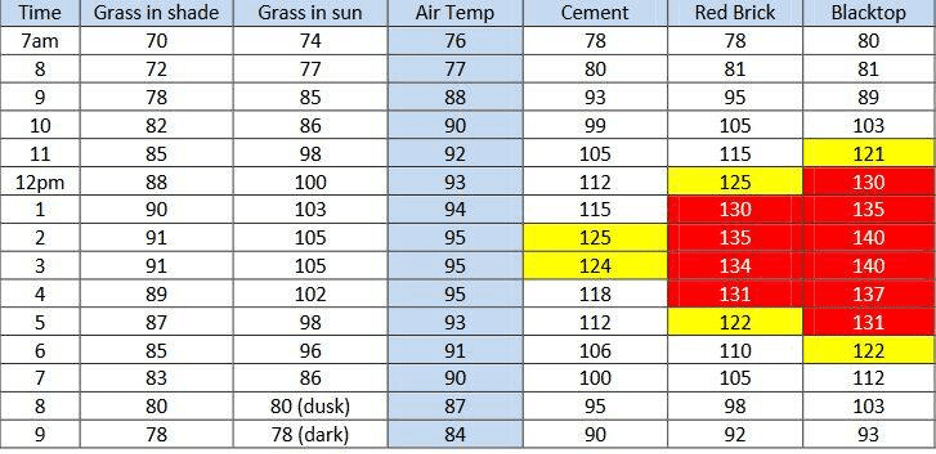What You Can Do About Excessively Hot Playgrounds
The Problem of Hot Playgrounds
Playground temperatures can soar well above 100 degrees Fahrenheit, posing significant health risks to students. Studies have shown that excessive heat can lead to heat exhaustion, heatstroke, and even death.
Provide A Little Shade
I’ve been writing about playgrounds and more specifically hot playgrounds for about 20 years. Twenty years ago, the topic was focused on the old metal playground jungle gym type play areas and children receiving second degree burns on hot summer days. In 2015 Texas Tech University conducted a research study entitled, “Dangerously hot playground temperatures explored by researcher.”[1] Researcher Jennifer Vanos pointed out, “the first step toward improving safety at playgrounds across the country is a simple obvious solution—provide a little shade.” Shade structures over play structures is a relatively simple solution and a cost-effective intervention especially when considering student health and safety. Twenty years ago, the focus was on metal swings, slides and jungle gyms and kids getting second degree burns.
Today headlines address squarely climate change and how it has contributed to rising heat temperatures exceeding 100 degrees on multiple days across much of America.
How schools respond to this occurrence will be critical for how it effects recess and student health going forward. For example, some schools keep students indoors when the heat exceeds 100 degrees. Other schools limit play to 5 minutes of activity followed by 5 minutes of cooling off in a shaded area. But the problem with these practices is that both significantly affect students outdoor recess activities which has amble research to support the importance of recess and the role it plays in academic success: 1) improving concentration, 2) helps to burn off energy so student return to class less fidgety and ready to learn among a variety of other academic benefits.


Where Children Play at Recess
In conjunction with the San Diego County Office of Education and San Diego State University I was involved in a study where we looked at where children play on playgrounds in 2020 for a Federal Physical Education for Progress (PEP) Grant. Our findings indicated that approximately 11% of student play on the playground structures, 39% play on the blacktop with painted games and 50% of elementary students play on the grass. In the visual below you can see findings from our research.
Benefits of Grass and Asphalt
The benefits of grass and asphalt are many. For this reason, I would caution against removing asphalt. Nearly 39% of all students prefer to play on the asphalt if they have marked games and equipment. The asphalt and grass combined indicated that 89% of students preferred to play in these two areas of the playground. Perhaps that is because they offer unique game opportunities to collaborate with friends in a self -elected activity. We found that game activates were the key to engaged children at recess. When children were wandering around with nothing to do problems and confrontations rose. Remember the saying, “Idle hands are the devils workshop?” that applies to the playground as well. When children have game options and equipment most will self-select to be involved in a game. Self-select is an important distinction. In the SD PEP Study, we did not tell students what to do during recess we merely added painted markings and provide adequate game/consumable equipment (sports balls, tether balls, jump ropes etc.) needed for game participation.
Removing asphalt will eliminate a play area that many students prefer to play. It allows for group play and involvement which there are few opportunities for in school classrooms. Game participation requires social interactions with peers and contributes to social skill development like leadership, cooperation, and learning to be a team player.
Removing asphalt trend
Some solutions schools are exploring will affect recess and children’s health. A recent headline in the Washington Post said, “Why schools are ripping up playgrounds across the U.S.”[1] Primarily this is due to research that indicates that asphalt surfaces, playground structures and mat surfaces (like those under playground structures that cushion falls) are sources of elevated heat. You may be wondering, “How hot does the pavement get in the summer?”[2] The chart below points out that asphalt is the hottest surface which may be the reason for removing asphalt for trees and grass.

Alternatives that May be Better that Removing Asphalt
Let’s explore a combination of alternatives to removing asphalt that are being considered:
- Adding trees and grass aiming for a “nature” enriched environment.
- Adding sun sails to playground play areas and over playground structures.
- Building covered pavilions (permanent structures like patio covers.)
- Adding misters to playground with covered areas for children to go to so they can cool down during recess.
- Add water stations so children can rehydrate during recess or when outside.
- Allow water bottles at student desks or on the playground to make water easily available on hot days.
Shade Structures or Sun Sails
When I was an elementary school principal my school was in Southern California about 60 miles from Palm Springs. It was not unusual to experience 100+ days frequently during the summer months and into early fall. We chose to have a pavilion installed and added misters to the outer rim of the pavilion as an antidote to the rising heat.
Contrary to popular belief, misters are inexpensive, use a small amount of water and are easy to install and maintain. Here is a link to an article that I wrote recently which explains the many benefits of misters. It’s entitled, “Misters: A cool answer to hot playgrounds.” [1]
Grass and Trees
A word of caution. Adding trees to a playground can often take between 5-10 years (or more) to fully grow enough to result in a large, shaded area. So, it’s best to think of this as a long-range plan. But temperatures are too hot now.
The solution some are exploring is to rip out asphalt and add mostly grass, but this can be problematic as well. While it’s true, the largest number of students preferred to play on the grass at recess (50%) the other half didn’t.
I’ll refer to my experience as a principal. Unlike those all but perfect “days gone by” schools are not the same as they were 30+ years ago when we were in school. Take for example school population numbers. The average elementary school size[1] across America today is 522 students in an elementary school. When I was in elementary school in CA the school size was less than 200 students. Larger student bodies put a greater strain on grass and the maintenance it requires. Costs include watering, mowing, and upkeep on sprinklers etc. must be figured into your budget because none of those are likely current expenses with asphalt. Another problem with grass that should be considered (besides costs) is that schools today are high intensity usage environments. Not only will schools use the playground and grass areas during the school day but the community of local sports teams will often use school facilities and grass fields as well. This high volume of usage leads to dying grass followed by a muddy field to contend with. Over watering contributes to this as well as, typical rainy weather in many areas. I can’t tell you how many times students had to “stay off the grass “due to the condition of the field whether it was to let the grass re-seed or to avoid muddy feet returning to classrooms.
Planning for the future in a heat intensive environment
Let’s not forget that most schools today are housing larger student bodies than they had to contend with 50 years ago, yet the size of most school yards haven’t changed while facility usage has more than doubled in many cases. Planning now for the next 50 years is necessary given climate change and the staying power of schools.
Tips for Principals
- Assess your playground: Evaluate your playground to identify areas that lack shade.
- Create a shade plan: Develop a plan to add shade structures to your playground.
- Prioritize shade: Make shade a priority in your school’s budget and planning.
- Educate your staff and students: Teach your staff and students about the importance of staying cool and hydrated. (Check out our “Keeping Kids Cool at School” article.)
- Monitor playground temperatures: Regularly monitor playground temperatures to ensure they are safe for students.
By taking the steps above, you can help create a safer and healthier playground environment for your students.
Resources and Grants
Resources
Keeping Kids Cool at School article.
Scientists don’t yet know why some people become seriously ill while exercising in hot weather, and others don’t. “There’s still a lot we don’t understand” about heat illness, says Douglas Casa, an associate professor in the Department of Kinesiology at the University of Connecticut.
Misters: A Cool Answer to Hot Playgrounds article.
As temperatures continue to climb this summer and smoke from fires spread across various parts of the U.S., schools across the U.S. are beginning to explore long-term options for reducing heat exposure. One solution that is gaining popularity is the use of misting systems.
How Schools Can Protect Schools from Wildfire Smoke.
Here are some things schools can do to protect students and learn to live with wildfire smoke.
Grants
Keeping Kids Cool at School article.
Scientists don’t yet know why some people become seriously ill while exercising in hot weather, and others don’t. “There’s still a lot we don’t understand” about heat illness, says Douglas Casa, an associate professor in the Department of Kinesiology at the University of Connecticut.
Misters: A Cool Answer to Hot Playgrounds article.
As temperatures continue to climb this summer and smoke from fires spread across various parts of the U.S., schools across the U.S. are beginning to explore long-term options for reducing heat exposure. One solution that is gaining popularity is the use of misting systems.
How Schools Can Protect Schools from Wildfire Smoke.
Here are some things schools can do to protect students and learn to live with wildfire smoke.
Sited References
[1] Bossenmeyer EdD., Melinda “Misters: A Cool Answer to Hot Playgrounds.” July 2024, Play Nice Newsletter. Peaceful Playgrounds, Inc. https://peacefulplaygrounds.com/featured-articles-members/misters-a-cool-answer-to-hot-playgrounds/
Texas Tech University. “Dangerously hot playground temperatures explored by researcher.” ScienceDaily. ScienceDaily, 11 November 2015. <www.sciencedaily.com/releases/2015/11/151111172514.htm>
[2] Bossenmeyer, Melinda. 10 Reasons Recess is so Important. Featured Articles Peaceful Playgrounds. https://peacefulplaygrounds.com/featured-articles-members/10-reasons-why-recess-is-so-important/
[3] American Academy of Pediatricians. The Crucial Role of Recess in School. January 2013 first publication. Reaffirmed April 2023. https://publications.aap.org/pediatrics/article/131/1/183/30893/The-Crucial-Role-of-Recess-in-School?
[4] Anna Phillips, Why Schools are ripping up playgrounds across the U.S., Washington Post, September 14, 2024. https://www.washingtonpost.com/climate-solutions/2024/09/14/playgrounds-asphalt-schools-cool-shade/
[5] Pam Knox. How hot does pavement get in summer? May 12, 2022. UGA Cooperative Extension. https://site.extension.uga.edu/climate/2022/05/how-hot-does-pavement-get/
[6] Bossenmeyer EdD., Melinda “Misters: A Cool Answer to Hot Playgrounds.” July 2024, Play Nice Newsletter. Peaceful Playgrounds, Inc. https://peacefulplaygrounds.com/featured-articles-members/misters-a-cool-answer-to-hot-playgrounds/
[7] National Center for Educational Statistics. https://nces.ed.gov/programs/digest/d23/tables/dt23_214.40.asp
[8] Green Schoolyards America. National initiative to transform asphalt-covered school grounds to park-like green spaces.

